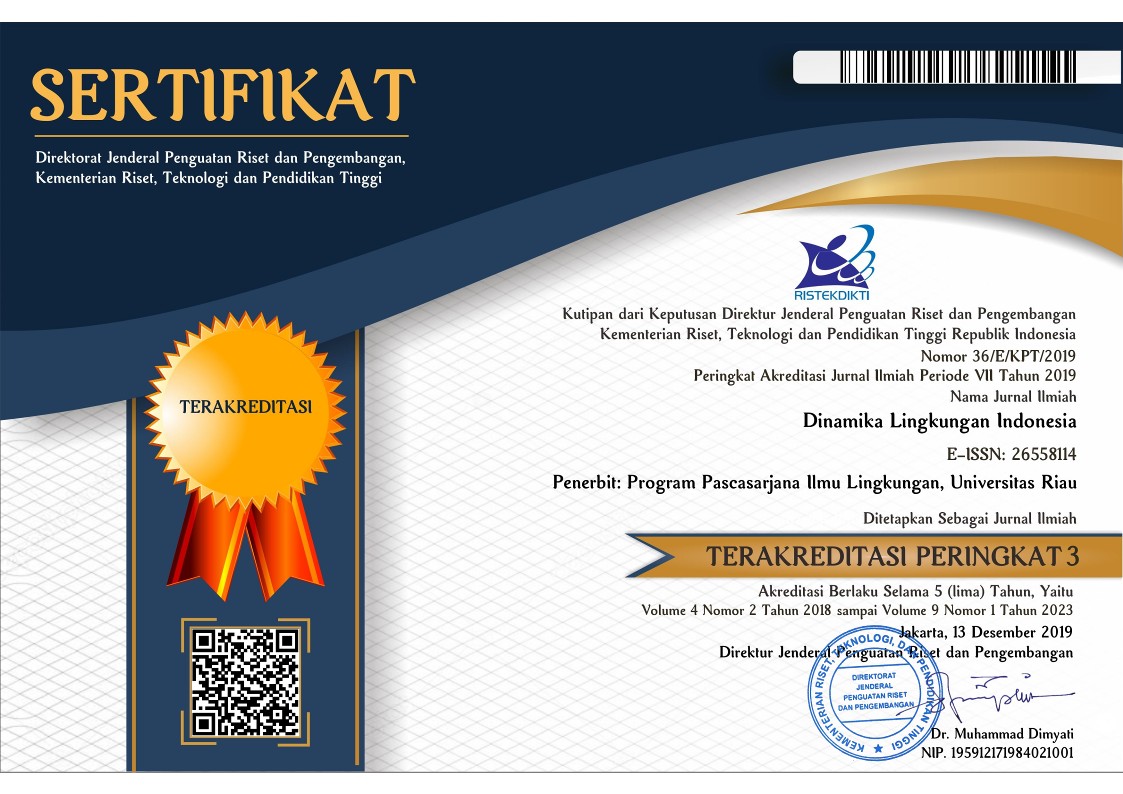Efek Konsentrasi Partikel Plastik Terhadap Pertumbuhan dan Kelangsungan Hidup Ikan Bawal Bintang (Trachinotus Blochii)
Abstract
Plastic pollution / waste has an impact that will disturb the stability of the ecosystem, especially aquatic organisms such as fish. The main source of plastic contamination comes from household waste that is not managed properly, especially in coastal areas that make the sea as a place of final discharge. Plastic pollution is currently the main problem that is accepted by the environment, especially water. Plastic will dissolve in the waters and will form small sizes (micro-plastic) impacting biota, including fish. Fish including aquatic organisms that can not distinguish between food and plastic particles clearly, thus providing an effect on digestion and growth. The results showed the growth rate of silver Pompanoo with the highest plastic concentration will cause slower growth, the control treatment is the best growth yield compared to treatments that have a plastic content mixed with feed. Growth of weights with the highest concentration of plastic particles is 0,48 gr/week, length growth is 0.75 cm / week, and survival is 69.17% and shows the growth and survival rates are worse or there is a tendency to worsen with an increase in the concentration of plastic contamination . Plastic particles consumed by fish are not digested properly and can even cause the growth response of fish to be slow even to death.
Keywords
Full Text:
PDFReferences
Alejos. M. S, Serrano. A. E. 2018. Continuous illumination improves growth and survival in the early stage of snubnose pompano Trachinotus blochii. AACL Bioflux 11 (5) : 1557-1563.
Arrokhman. S, Abdulgani, Hidayati. D. 2012. Survival Rate Ikan Bawal Bintang (Trachinotus blochii) dalam Media Pemeliharaan Menggunakan Rekayasa Salinitas. Jurnal Sains dan Seni 1 (1) : 32-35.
Brate. I. L, Huwer. B, Thomas. K. V, Eidvoll. D. P, Halsband. C, Almroth. B. C, Lusher. A. 2017. Micro-and macro-plastics in marine species from Nordic waters. Rosendahls : 102 hlm.
Chaves. H. M, Fang. A. L, Carandang. A. A. 2011. Effect of Stocking Density on Growth Performance, Survival and Production of Silver Pompano, Trachinotus blochii, (Lacépède, 1801) in Marine Floating Cages. Asian Fisheries sciences 24 : 321-330.
Crithell. K, Hoogenboom. M. O. 2018. Effects of microplastic exposure on the body condition and behaviour of planktivorous reef fish (Acanthochromis polyacanthus). Researce Article March : 1-19.
Food And Agriculture Organization Of The United Nations (FAO). 2017. Microplastics in fisheries and aquaculture Status of knowledge on their occurrence and implications for aquatic organisms and food safety.
Gerber. K. 2015. Effects Of Plastic Pollution On Deep Ocean Biota and Ecosystems. [thesis]. University of Oregon. 28 hlm.
Hidayat. K, Yulianto. H, Ali. M, Noor. N.M, Putri. B. 2019. Performance of snubnose pompano Trachinotus blochii in both monoculture and polyculture within green mussels Perna viridis cultivated on raft system. Depik 8 (1) : 1-8.
Jayakumar. A. B. N, Tamilmani. G, Sakthivel, Kalidas. C, Kumar. P. R, Anbarasu. M, Sirajudeen. S, Balamuguran. V, Jayasingh. M, Gopakumar.
G. 2012. Larviculture and seed production of the silver pompano, Trachinotus blochii (Lacepede, 1801) for the first time in India. Journal of Indian Fish 59 (3) : 83-87.
Kalidas. C, Sakthivel. M, Tamilmani. G, Kumar. P. R, Nazar. A. B, Jayakumar. R, Balamurugan, Ramkumar, Premjothi, Gopakumar. G. 2012. Survival and growth of juvenile silver pompano Trachinotus blochii (Lacepède, 1801) at different salinities in tropical conditions. Indian Fish 59 (3) : 95-98.
Liboiron. M. 2016. Redefining pollution and action: The matter of plastics. Journal of Material Culture 21 (1) : 87-110.
Marzuqi. M. Anjusary. D. N. 2013. Nutrient Digestibility Feed With Different Levels Of Protein And Lipid On Coral Rock Grouper (Epinephelus Corallicola) Juvenile. Jurnal Ilmu dan Teknologi Kelautan Tropis 5 (2) : 311-323.
Pinheiro. C, Oliveira. U, Veira. M. 2017. Occurrence and Impacts of Microplastics in Freshwater Fish. Journal of Aquaqulture and Marine Biology 5 (6) : 2-5.
Putra. W. K. A, Handrianto. R, Razai. T. 2017. Maturation of the Silver Pompano (Trachinotus blochii) Gonad by Hormon Human Chorionic Gonadotropin (hCG) and Pregnant Mare Serum Gonadotropin (PMSG). Jurnal Perikanan Universitas Gadjah Mada 19 (2) : 75-78.
Putri. A. K, Anggoro. S, Djuwito. 2014. Osmotic Performance Rate and Development of Silver Pompano Seeds Biomass (Trachinotus blochii) which Cultivated on Media with Different Salinity. Journal Maquares 4 (1) : 159-168.
Solomon. O. O, Palanisami. T. 2016. Microplastics in the Marine Environment: Current Status, Assessment Methodologies, Impacts and Solutions. Journal Pollut Eff Cont 4 (2) : 2-13.
Wijaya. A, Damayanti. A. A, Astriana. B. H. 2018. Pertumbuhan Dan Efisiensi Pakan Ikan Bawal Bintang (Trachinotus blochii) Yang Dipuasakan Secara Periodik. Jurnal Perikanan 8 (1) : 1-7.
DOI: http://dx.doi.org/10.31258/dli.7.1.p.13-16
Refbacks
- There are currently no refbacks.





